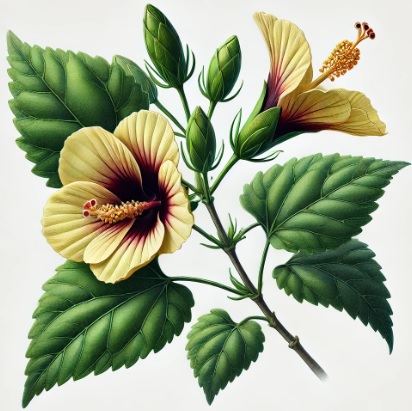Hibiscus hamabo, commonly known as the Hamabo Hibiscus, is a species of hibiscus native to East Asia, particularly Japan and China. This shrub is admired for its large, vibrant flowers and distinctive foliage. Hibiscus hamabo is often found in coastal areas and is known for its tolerance to salt and its decorative appeal in landscapes.
Botanical Classification:
Family: Malvaceae
Genus: Hibiscus
Species: H. hamabo
Common Names: Hamabo Hibiscus, Japanese Coastal Hibiscus
Plant Characteristics:
Size: Typically grows to about 1.5 to 3 meters (5 to 10 feet) in height and can spread widely.
Leaves: The leaves are large, ovate to lanceolate, with a glossy, dark green surface. They are alternately arranged and can have a serrated margin.
Flowers: The flowers are large, showy, and can be white, pink, or yellow with darker centers. Each flower is approximately 8-12 cm (3-5 inches) in diameter and has five petals.
Fruit: The plant produces a capsule fruit that contains seeds, which are often dispersed by wind or water.
Chemical Composition and Structure:
The chemical composition of Hibiscus hamabo includes:
Flavonoids: Such as quercetin and kaempferol, which are known for their antioxidant and anti-inflammatory properties.
Tannins: Contributing to the astringent qualities and antimicrobial activity of the plant.
Anthocyanins: Pigments responsible for the flower's vibrant colors, with antioxidant effects.
Mucilage: Found in the plant’s tissues, which may have soothing and moisturizing properties.
Uses and Benefits:
Cosmetic: Hibiscus hamabo extract is used in skincare for its antioxidant and anti-inflammatory properties. It helps to enhance skin appearance by improving texture and reducing signs of aging.
Medicinal: In traditional medicine, it may be used for its potential anti-inflammatory and antimicrobial properties, though it is less commonly used than other Hibiscus species.
Ornamental: Widely cultivated for its attractive flowers and foliage. It is used in landscaping to add color and aesthetic appeal to gardens and coastal areas.
Ecological: Provides habitat and food for various pollinators such as bees and butterflies, contributing to local biodiversity.
Applications:
Cosmetics: Included in formulations such as creams, serums, and masks for its anti-aging, soothing, and antioxidant properties.
Landscaping: Planted in gardens, parks, and coastal areas for its decorative value and ability to tolerate salt and harsh conditions.
Environmental and Safety Considerations:
Environmental Impact: Hibiscus hamabo is well-suited to coastal environments and is relatively low-maintenance once established. It contributes positively to the ecosystem by supporting pollinators and is adapted to withstand saline conditions.
Safety: Generally considered safe for use in cosmetics and herbal remedies. Individuals with sensitivities to plants in the Malvaceae family should exercise caution.
INCI:
Antioxidant agent. Ingredient that counteracts oxidative stress and prevents cell damage. Free radicals, pathological inflammatory processes, reactive nitrogen species and reactive oxygen species are responsible for the ageing process and many diseases caused by oxidation.
Skin protectant. It creates a protective barrier on the skin to defend it from harmful substances, irritants, allergens, pathogens that can cause various inflammatory conditions. These products can also improve the natural skin barrier and in most cases more than one is needed to achieve an effective result.
Skin conditioning agent. It is the mainstay of topical skin treatment as it has the function of restoring, increasing or improving skin tolerance to external factors, including melanocyte tolerance. The most important function of the conditioning agent is to prevent skin dehydration, but the subject is rather complex and involves emollients and humectants that can be added in the formulation.
Synonyms:
CAS:
![]() Hibiscus Hamabo
Hibiscus Hamabo 

